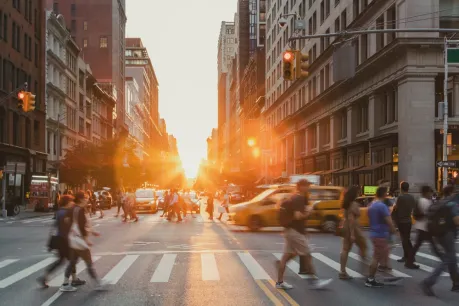Jacksonville’s Most Dangerous Intersections

Injured?
Jacksonville is a city on the move. From the bustling bridges that crisscross the St. Johns River to the ever-growing neighborhoods stretching across Duval County, the roads are always busy—and not always safe.
For residents and visitors alike, understanding Jacksonville’s most dangerous intersections could mean the difference between a routine commute and a devastating collision.
Every year, thousands of crashes happen in the same trouble spots. The same intersections. The same deadly patterns. And yet, too few drivers know where Jacksonville’s real crash zones are or why they’ve remained so dangerous for so long.
In this guide, we’re mapping out the most accident-prone intersections in Jacksonville, diving into the data behind the crashes, and exploring how poor road design, heavy traffic, and split-second decisions can change lives.
If you’ve ever wondered which intersections to approach with extra caution or what legal rights you have after a crash at one of these known hotspots, read on. And if you find yourself in the aftermath of a Jacksonville intersection car accident that wasn’t your fault, contact Morgan & Morgan for a free case evaluation to learn more about your legal options.
The Most Dangerous Roads and Intersections in Jacksonville
When it comes to car accidents in Jacksonville, a few intersections repeatedly rise to the top of the danger list. Whether it’s due to poor design, overwhelming traffic, or reckless driving habits, these locations are notorious for crashes, and locals know to approach with caution. Here are the worst offenders:
1. Blanding Blvd & Youngerman Circle
Why it’s risky: Heavy merging traffic, multiple shopping centers, and confusing turn lanes.
Hotspot status: This intersection regularly sees dozens of crashes a year and is one of Jacksonville’s most complained-about junctions.
Common accidents: Rear-end collisions, side-swipes, and left-turn crashes.
2. Southside Blvd & Touchton Road
Why it’s risky: This fast-moving corridor is crammed with businesses and drivers rushing between errands.
High-risk factor: High-speed traffic and frequent lane changes create the perfect storm for fender benders and serious wrecks alike.
3. Atlantic Blvd & Southside Blvd
Why it’s risky: A chaotic blend of commercial traffic, tight intersections, and aggressive drivers.
Crash types: Left-turn crashes and pedestrian incidents are common here — especially during peak hours.
4. I-295 Beltway Interchanges
Why it’s risky: Merging traffic at high speeds, construction zones, and limited visibility.
Deadly mix: These interchanges, especially near Blanding Blvd or JTB, are among the most dangerous spots for major highway collisions in Duval County.
5. University Blvd & Atlantic Blvd
Why it’s risky: Complex lane layouts and unpredictable driver behavior at this older intersection.
Bonus hazard: Its location near schools and hospitals makes pedestrian safety a growing concern.
6. Baymeadows Road & Southside Blvd
Why it’s risky: Congested with commuter and delivery traffic, especially during morning and evening rush hours.
Added risk: Distracted driving is a major issue here, often contributing to multi-car pileups.
7. Normandy Blvd & Lane Avenue
Why it’s risky: Poor visibility, inconsistent signal timing, and speeding drivers.
Watch out: This Westside junction continues to see a spike in accidents, especially at night.
Year-by-Year Crash Statistics in Duval County
Duval County crash data reveals troubling trends. Each year, thousands of accidents occur within Jacksonville city limits. While exact numbers vary annually, the Florida Department of Highway Safety and Motor Vehicles (FLHSMV) typically reports more than 20,000 crashes per year in Duval County.
Recent statistics show:
- 2020: Approximately 21,211 total crashes
- 2021: Over 24,300 total crashes
- 2022: Nearly 25,000 total crashes
- 2023 (preliminary): An increase in pedestrian and cyclist injuries at major intersections
The data highlights not just volume, but severity. Many of these collisions occur at the same few intersections year after year, making them a growing concern for both local officials and residents.
Common Causes of Crashes at Jacksonville Hotspots
Why do certain intersections experience more crashes than others? Here are the most common contributing factors:
- Driver Distraction: Cell phone use, in-car tech, and other distractions are frequently cited in collision reports.
- Speeding: Many of Jacksonville’s arterial roads, like Southside Boulevard, see drivers exceeding speed limits, especially during off-peak hours.
- Poor Visibility: Intersections like 103rd & Ricker are known for obstructed views due to overgrown vegetation or poorly positioned signage.
- Heavy Traffic Volume: Intersections that connect major residential areas to business corridors naturally see more vehicles and more chances for crashes.
- Confusing Lane Configurations: Inadequate signage or unclear lane markings, particularly near Blanding Boulevard, contribute to side-swipes and rear-end collisions.
The Role of Poor Signage and Traffic Design
In many cases, the infrastructure itself may be to blame. Inadequate traffic signals, missing pedestrian crosswalks, faded lane markings, and outdated traffic flow designs all create dangerous situations.
Take Beach and Hodges, for example. This intersection has long been a source of frustration for drivers due to unclear turning lanes and short yellow lights. The poor design makes it hard for drivers to judge when to yield or proceed, leading to T-bone crashes and fender benders during peak hours.
Similarly, the intersection of Southside and Baymeadows sees a dangerous mix of commuter traffic, commercial entrances, and limited merge lanes. Accidents here often stem from drivers trying to make last-second lane changes or misjudging oncoming traffic while making a turn.
Legal Implications of Crashes at Known Danger Zones
If you’re injured in an accident at a well-known danger zone, it could have legal implications in your favor.
When an intersection is known to be hazardous, city or state agencies could potentially share liability if they failed to take appropriate action to address the danger. This concept, known as premises or roadway liability, can play a role in determining fault in your case.
At Morgan & Morgan, we’ve handled many personal injury claims where a dangerous roadway condition, like a lack of signage or improper traffic light timing, was a contributing factor. Our attorneys have the resources to investigate road design flaws, subpoena city planning documents, and fight for full compensation.
How Jacksonville Compares to Other Florida Cities
When it comes to accident-prone areas, Jacksonville ranks high among Florida’s largest metros. While Miami and Orlando are notorious for traffic congestion, Jacksonville’s unique combination of suburban sprawl and limited mass transit options results in a high per-capita accident rate.
Moreover, Jacksonville sees a higher percentage of accidents involving large trucks and a growing number of pedestrian-related incidents compared to cities like Tampa and St. Petersburg.
Safety Tips for Navigating Jacksonville’s Dangerous Intersections
If you drive in Jacksonville regularly, here are some tips for navigating high-risk intersections more safely:
- Approach cautiously: Assume other drivers may not obey signals, especially during rush hour.
- Avoid distractions: Put your phone away and keep both hands on the wheel.
- Slow down at intersections: Even if you have the right-of-way, reduce speed when entering an intersection.
- Double-check for pedestrians: Especially near crosswalks without flashing signals.
- Avoid yellow-light gambles: Don’t try to “beat the red.” Many of Jacksonville’s lights are timed tightly, leading to red-light crashes.
Frequently Asked Questions
What are the most dangerous intersections in Jacksonville?
Some of the most dangerous intersections include:
- Blanding Blvd & Youngerman Circle
- Southside Blvd & Baymeadows Rd
- Beach Blvd & Hodges Blvd
- 103rd St & Ricker Rd
- Atlantic Blvd & Southside Blvd
These locations consistently appear in crash reports and are considered car accident hotspots in Duval County.
Why are certain roads in Jacksonville more prone to accidents?
Certain roads in Jacksonville are more prone to accidents due to a combination of infrastructure challenges, driver behavior, and traffic volume. Here’s a breakdown of why these roads turn into crash hotspots:
High Traffic Volume
Jacksonville is one of the largest cities in the U.S. by land area, and many of its roads, like Southside Blvd, Blanding Blvd, and I-295, carry tens of thousands of vehicles each day. The more vehicles on a road, the greater the chance of collisions, especially during rush hour or in areas with heavy commercial traffic.
Poor Intersection Design
Some intersections weren’t built to handle today’s traffic flow. Narrow lanes, confusing signage, short turn lanes, and limited visibility can lead to frequent driver errors. Intersections like Atlantic Blvd & Southside Blvd are known for these design flaws, contributing to a high rate of side-impact and rear-end crashes.
Aggressive or Distracted Driving
High-speed corridors and long stretches of roadway can encourage speeding. Meanwhile, distracted driving, especially due to phones, GPS, or food, plays a major role in local crashes. Roads like Baymeadows or University Blvd see regular incidents caused by drivers who are simply not paying attention.
Inadequate Signage or Traffic Signals
Outdated signals, missing signage, and inconsistent traffic light timing can confuse drivers. In areas with frequent signal malfunctions or poorly marked lanes, drivers are more likely to make dangerous turns or stop abruptly.
Poor Lighting and Visibility
Certain areas of Jacksonville, especially older neighborhoods or stretches of highway, lack proper street lighting or have obstructions like overgrown trees or unclear road markings. Poor visibility increases the risk of nighttime crashes and pedestrian accidents.
Road Construction and Detours
With Jacksonville constantly expanding, construction zones are a common sight. Sudden detours, temporary signals, and uneven pavement can easily contribute to fender benders and more serious crashes, particularly around I-10, I-95, and I-295.
Mixed-Use Traffic
Some of the most dangerous roads serve a mix of vehicles: semis, buses, delivery vans, cyclists, and pedestrians. When these different users share the same space without dedicated bike lanes or crosswalks, it increases the likelihood of serious injury crashes.
Which intersection has the highest number of crashes?
Recent data shows that Blanding Boulevard and Youngerman Circle has one of the highest crash volumes in Jacksonville, particularly involving rear-end and side-impact collisions.
Are there any pedestrian accident hotspots in Jacksonville?
Yes, intersections like Blanding and Youngerman and 103rd and Ricker are particularly dangerous for pedestrians due to limited crossing signals and high-speed traffic.
How does traffic volume impact accident rates?
Traffic volume plays a major role in accident rates, especially in a sprawling, high-growth city like Jacksonville. Here’s how:
More Cars = More Opportunities for Collisions
The most basic reason: the more vehicles on the road, the more chances there are for a crash. High-volume roads like Southside Boulevard, Blanding Boulevard, and I-295 see tens of thousands of drivers daily, and even one moment of inattention can lead to a chain-reaction collision during peak hours.
Increased Stop-and-Go Driving
Heavy traffic often leads to stop-and-go movement, a prime condition for rear-end collisions. Drivers may not leave enough space between vehicles or react in time, especially if they’re distracted or frustrated.
Higher Driver Stress and Aggression
Congested roads test everyone’s patience. Long commutes, bottlenecks, and frequent delays can result in aggressive driving behaviors like speeding, tailgating, and erratic lane changes, all of which increase crash risk.
Limited Space for Maneuvering
When roads are packed, there’s simply less room to safely change lanes, merge, or avoid hazards. In high-volume intersections like Atlantic Blvd & Southside Blvd, this often leads to side-swipes, t-bone collisions, and multi-car pileups.
More Pedestrians and Cyclists in Busy Corridors
High-traffic areas tend to also attract foot and bike traffic, especially near shopping centers, schools, or downtown areas. Without proper crosswalks or bike lanes, this mix can be deadly, leading to a rise in pedestrian and cyclist accidents.
Longer Travel Times = Higher Exposure
More cars mean slower travel, which increases the amount of time drivers spend on the road, and the longer you're driving, the more exposed you are to risky conditions. This is especially true during Jacksonville’s extended rush hour periods on weekdays.
In Jacksonville:
Intersections like Blanding Blvd & Youngerman Circle or Southside Blvd & Touchton show a direct correlation between high traffic volume and high crash frequency, making them consistent hotspots year after year.
What time of day do most accidents occur in Jacksonville?
In Jacksonville, most car accidents occur during peak traffic hours, specifically the morning and evening rush hours. This trend mirrors national data but is especially noticeable in a city like Jacksonville where many residents rely on personal vehicles to get to work, school, or run errands.
Morning Rush (7:00 AM – 9:00 AM)
At this time, drivers are often in a hurry, distracted, or fatigued, and school zones and commuter routes like Blanding Blvd, I-295, and Southside Blvd become especially congested.
Accidents during this time tend to involve rear-end collisions, side-swipes, and intersection mishaps caused by rushed left turns or red-light running.
Evening Rush (4:00 PM – 6:30 PM)
This is the most dangerous time of day for Jacksonville drivers. Roads are packed with people leaving work, picking up kids, or heading to evening activities. Driver fatigue, impatience, and high traffic volume converge, especially at known hotspots like Atlantic Blvd & Southside Blvd or Baymeadows Road.
Nighttime Risks (9:00 PM – 2:00 AM)
While there are fewer cars on the road at night, accidents during this window are often more severe. This is when:
- Impaired driving (due to alcohol or drugs) spikes.
- Visibility is reduced, especially in poorly lit areas of Jacksonville.
- Pedestrian fatalities increase, particularly near nightlife zones or crosswalk-deficient corridors.
Are there any city plans to improve these dangerous areas?
Yes, the City of Jacksonville and the Florida Department of Transportation have proposed various upgrades, including better traffic light timing, added signage, and pedestrian-focused improvements. However, implementation can be slow due to funding constraints.
Is Southside Blvd a high-risk road for accidents?
Absolutely. Southside Boulevard is one of the most accident-prone roads in Jacksonville, particularly at intersections like Southside & Baymeadows and Southside & Atlantic.
What should I do if I’m in an accident at a known hotspot?
If you’re in an accident at one of Jacksonville’s known hotspots, like Blanding Boulevard, Southside Boulevard, or Atlantic & Kernan, it’s important to take specific steps to protect your health, your rights, and your potential injury claim. Here’s what to do:
1. Get to Safety
If you can, move your vehicle to the side of the road or out of the intersection. Hotspot areas are often high-traffic zones, so getting out of the flow of vehicles can prevent a secondary accident.
2. Call 911 Immediately
Even if the crash seems minor, you need a police report, especially when the accident happens at a high-risk intersection. Law enforcement will document what happened, which can be critical for your insurance claim or legal case later.
3. Document Everything
Take photos or videos of:
- Your vehicle and any visible damage
- The other car(s) involved
- The intersection or road signs (especially if poor signage or design may have contributed)
- Skid marks, debris, or traffic signals
- Any injuries, if visible
These visuals can help prove liability, particularly if road design or traffic flow played a role.
4. Talk to Witnesses
If anyone nearby saw what happened, pedestrians, cyclists, or other drivers, ask for their contact info. Independent witnesses can be invaluable when accidents occur at intersections known for frequent crashes.
5. Seek Medical Attention ASAP
Even if you don’t feel seriously hurt, some injuries (like whiplash, concussions, or internal trauma) take hours or days to show symptoms. Getting checked out right away documents your injuries and helps tie them to the accident.
6. Contact Morgan & Morgan
When a crash happens at a known dangerous intersection, you may be entitled to more than just compensation from the other driver. If poor traffic design, faulty signals, or city negligence contributed to the accident, you could have a case against a municipality or third party.
At Morgan & Morgan, we’ve helped thousands of people who were hurt in Florida’s most accident-prone areas. We know the roads, the patterns, and how to fight back when something preventable leads to real harm.
7. Don’t Sign Anything Without Legal Advice
Insurance companies may try to offer a quick settlement, especially when they know the accident occurred at a high-risk area. Don’t accept it until you’ve spoken with a lawyer who can determine what your case is really worth.
Can I file a claim if an intersection design contributed to my accident?
Yes, you may be able to file a claim against a city or state agency if poor design or lack of maintenance played a role in your crash. Morgan & Morgan has the experience and resources to pursue these complex claims.
If you or a loved one has been involved in a car accident at one of Jacksonville’s dangerous intersections, you don’t have to face the aftermath alone. At Morgan & Morgan, we understand how overwhelming it can be to deal with insurance companies, medical bills, and legal complexities, especially when road design or city negligence played a role.
It can add insult to injury to know that your accident was caused by someone else’s negligence, but the good news is that you can fight for justice and the compensation you need and deserve to move forward with your life.
Our Jacksonville attorneys have decades of experience and know the local laws that pertain to a Jacksonville car accident claim. Hiring one of our lawyers is easy, and you can get started in minutes with a free case evaluation.

We've got your back
Injured?
Not sure what to do next?
We'll guide you through everything you need to know.

